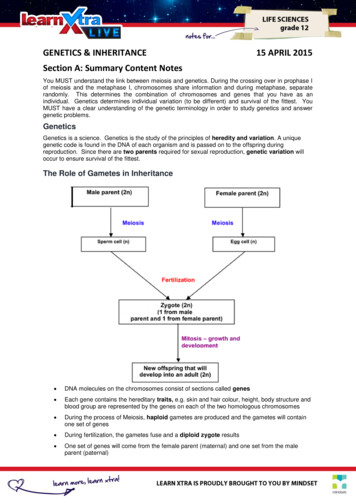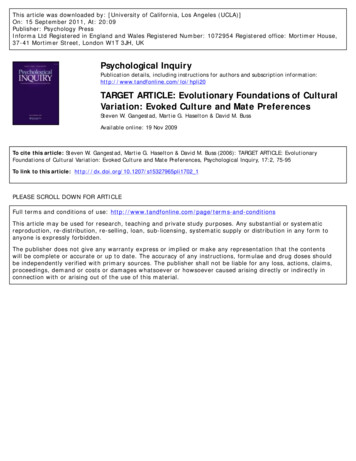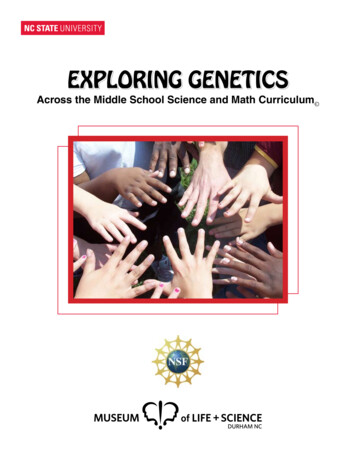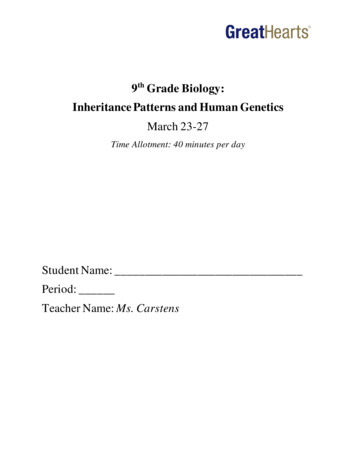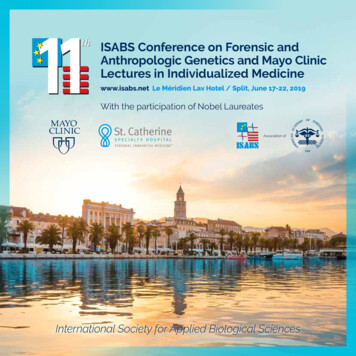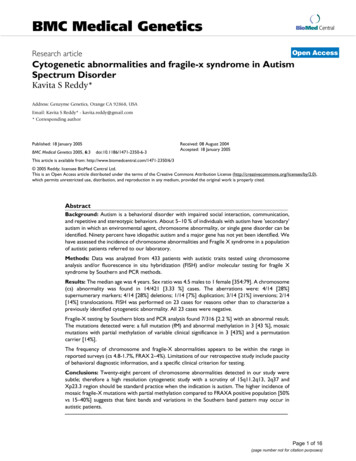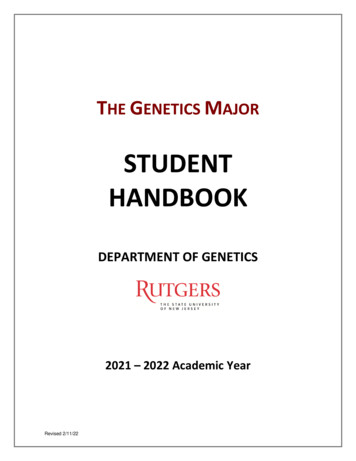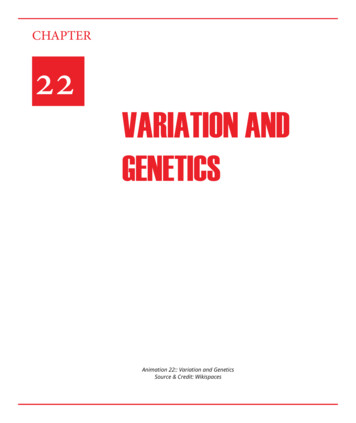
Transcription
CHAPTER22VARIATION ANDGENETICSAnimation 22:: Variation and GeneticsSource & Credit: Wikispaces
22. Variation And GeneticseLearn.PunjabGENES, ALLELES AND GENE POOLHereditary characteristics pass from parents to ofspring through genes in theirgametes. Gene is the basic unit of biological information. In fact DNA stores all sorts ofbiological information coded in the sequence of its bases in a linear order, and genesare actually parts of DNA comprising its base sequences. The position of a gene on thechromosome is called its locus.Genes are responsible for producing startling inherited resemblences as well asdistinctive variations among generations. When these pass in the form of intactparental combination between generations, inherited similarities are conserved; butwhen these shule, mutate or juggle with each other, variations emerge. Genes formpairs on pairs of homologous chromosomes. One member of a gene pair is located onone homologue, and the other member on the other homologue. Partners of a genepair are called alleles. Each allele of a gene pair occupies the same gene locus on itsrespective homologue. Both alleles on one locus may be identical, or diferent fromeach other. (Fig. 22.1).Animation 22: Gene PoolSource & Credit: GIF SOUP2
22. Variation And GeneticseLearn.PunjabFig 22.1 Allelic pairs on a homologous pair of chromosomes3
22. Variation And GeneticseLearn.PunjabPhenotype is the form of appearance of a trait. Genotype is the genetic complementi.e., the genes in an individual for a particular trait. A lower may be red or white incolour. Flower colour is a trait and red and white are its two phenotypes. Each formof expression is determined-by a diferent allele of the colour gene. Allele “R” is thedeterminer for redness, while “r” is the determiner for whiteness.GENE POOLAny group of interbreeding organisms of the same species that exist together inboth time and space is called a population. All the genes/alleles found in a breedingpopulation at a given time are collectively called the gene pool. It is the total geneticinformation encoded in the total genes in a breeding population existing at a giventime.If we imagine population not as a group of individuals, but as a group of individuallysegregating and randomly assorting alleles, we can understand the concept of “beanbaggenetics”. The alleles are like beans in a beanbag. The entire beanbag full of beans isthe gene pool of the population. In the beanbag approach we can imagine the entiregene pool comprising all the alleles for all the diferent traits at once, or we can justfocus on some subset, such as all the alleles for a single trait.Jumping genes do not settle peacefully on their loci, they keep on hopping on diferentloci on the same chromosome or other chromosomes.For convenience, we can focus on the gene pool for a single particular trait. A samplepopulation of 100 diploid plants, some of which bear red lowers, others bearing whitelowers has a sum total of 200 of all the diferent alleles (R or r) for lower colour traitas its gene pool.4
22. Variation And GeneticseLearn.PunjabMENDEL’S LAWS OF INHERITANCEGregor Johann Mendel (1822 - 1884) laid the foundation of classical genetics byformulating two laws of heredity; law of segregation and law of independent assortment.He was a priest. He performed series of breeding experiments on garden pea, Pisumsativum in his monastery garden for eleven years (1854 — 1865). Pisum sativum waseasy to cultivate and it grew well in his garden. Its lowers were hermaphrodite. It wasnormally self-fertilizing, but could also be cross-fertilized. As the time gap betweengenerations was short, Mendel could raise many generations of pea within a short time.Pea had many sharply distinct traits. Each trait had two clear cut alternative forms orvarieties; e.g., seed shape had a round or wrinkled phenotype, plant height was eithertall or short, seed colour could be yellow or green. Mendel called them contrasting pairof a trait. He focussed on seven such pairs (Fig. 22.2).He irst established true-breeding lines or varieties for each trait. A true - breedingvariety upon self - fertilization always produced ofspring identical to the parents,e.g., a true breeding “round” seed plant produced only “round” seeds. Similarly, a truebreeding “wrinkled” seed plant produced only “wrinkled” seeds.After establishing 14 pure - breeding lines of seven characters, he cross-fertilizedplants that difered in one character only. The ofspring of such a cross were calledmonohybrids. He cross-fertilized a true breeding round-seeded male plant with a truebreeding wrinkled-seeded female plant (Fig. 22.3).Animation 22.2:Mendel’s Law of InheritanceSource & Credit: Ms.Anderson Biology Class5
22. Variation And GeneticseLearn.PunjabFig 22.2 Seven traits of garden pea studied by Mendel.6
22. Variation And GeneticseLearn.PunjabHe called it irst parental generation (Pi). Their ofspring were called Fi or irst ilialgeneration. All Fi ofspring were round like one of the parents. Wrinkled phenotype didnot appear at all. Round dominated wrinkled. Its dominance was complete because noofspring intermediate between parents was found. He called the trait that appearedin F, as dominant; while the trait,which was masked, as recessive.Then Mendel allowed selffertilization among F monohybridsto raise F2 progeny. As a result ofmonohybrid cross 3A of F2 wereround and lA wrinkled.Mendel got similar results andthe same 3:1 ratio in ofspring ofmonohybrid crosses for all theseven contrasting pairs of traits.Mendel proceeded a step ahead.He self- fertilized F2 plants to raiseF3. He noted that 1/3 of F2 roundproduced only round, while 2/3of F2 round produced both roundand wrinkled in . 3:1 ratio; but F1wrinkled produced only wrinkled.He concluded that 1/3 of F2rounds were true-breeding like Piround, and 2/3 of F2 rounds weremonohybrids like Fj round.Fig 22.3 Mendel’scross to study single trait inheritance in pea.7
22. Variation And GeneticseLearn.PunjabMendel’s InterpretationsMendel proposed that each contrasting form of a trait, e.g., roundness or wrinklednessof seed was determined by particulate hereditary factors, which he called ‘elementen’.These factors carrying hereditary information were transmitted from parents toofspring through gametes. Each pea plant had a pair of these factors, one derivedfrom male parent and the other from female parent. Both of these factors togethercontrolled expression of a trait. He designated dominant factor with a capital letter andrecessive factor with a small letter; e.g., R for roundness factor and r for wrinklednessfactor. Johannsen renamed them as ‘genes’.The true - breeding round seed plant of P generation carried ‘RR’ alleles while thetrue - breeding wrinkled seed plant of Pi carried ‘it’ alleles. When both the alleles of agene pair in an organism are same, the organism is homozygous for that gene pair. Anindividual with a homozygous genotype is a homozygote.Fig 22.4 Segregation of alleles during gamete formationMendel inferred that the factors of a pair (alleles) separated from each other duringgamete formation so that each gamete got only one factor (allele) for each trait. So halfthe gametes got one allele, and the other half carried the other allele. Fertilizationwas random. When male gamete carrying factor (R) fertilized female gamete with factor(r), the complete set of the two factors (Rr) for the trait was restored in zygote.8
22. Variation And GeneticseLearn.PunjabThe zygote developed into Fj ofspring that was heterozygous ‘Rr’, because the twoalleles of its gene pair were diferent from each other. An individual with a heterozygousgenotype is a heterozygote. Fi ofspring (Rr) was a monohybrid for seed shape; it wasround in phenotype but heterozygous in genotype. Its alleles also segregated duringgamete formation (Fig. 22.4).Punnett square indicates that lA of F2 progeny would have been ‘RR’ (homozygousround), lA lA Yi Rr (heterozygous round), and lA rr (wrinkled).Mendel actually observed 3 ; 1 phenotypic ratio in F2. His phenotypic data of F3 canalso be explained on the basis of 1 : 2 : 1 genotypic ratio of F2. Mendel comparedthe results of all the seven separately studied characters, and found them strikinglysimilar to formulate law of segregation.Law of Segregation : According to law of segregation, the two coexisting alleles foreach trait in an individual segregate (separate) from each other at meiosis, so that eachgamete receives only one of the two alleles. Alleles unite again at random fertilizationof gametes when zygote is formed.Test CrossMendel devised a cross called test cross, which is used to test the genotype of anindividual showing a dominant phenotype. It is a mating in which an individual showinga dominant phenotype is crossed with an individual showing its recessive phenotype.This cross inds out the homozygous or heterozygous nature of the genotype (Fig.22.5).Animation 22: Test CrossSource & Credit: Pinterest9
22. Variation And GeneticseLearn.PunjabCase 1If the seed is homozygous round(RR) itwill grow into a pea plant that forms allgametes with only R allele.Wrinkledseed plant is always homozygousrecessive.it will form all gametes with r allele.Fertilization will result in 100%round seed progeny.Case 2If the seed is heterozygous round (Rr), itwill grow into a plant that forms half thegametes, with ‘R and half with r allele.Wrinkled seed plant will form only r type of gametes. Fertilization will resultinto 50% round and 50% wrinkled seedprogeny. Even a single wrinkled seed inthe progeny is a convincing proof forHeterozygousnature of the roundparent.Fig 22.5 Test cross of a round seed10
22. Variation And GeneticseLearn.PunjabDihybrid and Dihybrid CrossAfter thoroughly studying each trait separately , Mendel decided to study the inheritanceof two simultaneously , e.g., seed shape and seed colour. Seed shape could be roundor wrinkled. Similarly , seed colour could be yellow or green. He crossed true breedinground and yellow seed plants with true breeding wrinkled and green seed plants . All F1dihybrid were round and yellow seeded due to dominance. Then he made a dihybridcross by allowing self-fertilization among F1 dihybrids. The results was quite surprising.Seeds produced as F2 progeny were ot only in the two parental combination i.e.,round yellow and wrinkled green, but also in two new phenotypic combinationi.e., round green and wrinkled yellow. A clear cut 9:3:3:1 phenotypic ratio was foundin F2. Appearance of these new recombinant phenotypes of F2 indicated that somesort of shuling of alleles had occurred during gemete formation. Mendel inferredthe mechanism of this shuling as independent assortment of alleles into gametes.He concluded that the alleles for seed shape and colour were not bound to remain inparental combination forever, i.e., ‘R’ with ‘Y’ and ‘r’ with ‘y’ ;rather these were free toassort independently . R could go with Y or y in any gamete with equal change.Animation 22: Dihyrid CrossSource & Credit: GIF SOUP11
22. Variation And GeneticseLearn.PunjabSimilarly, r could go with y or Y in any gamete with equal probability. Four types ofgametes, i.e., RY, Ry, rY and ry were formed in equal number in a perfect ratio of 1:1: 1:1. When these gametes randomly fertilized each other, a 9:3:3:1 phenotypic ratiowas produced among F2 progeny (Fig 22.6).Mendel formulated Law of Independent Assortment : “When two contrasting pairs oftraits are followed in the same cross, their alleles assort independently into gametes.”Alleles of one pair inherit independently of alleles of the other pair. The distribution ofalleles of one trait into gametes has no inluence on the distribution of alleles of theother trait. Thus the chance for a plant to be round or wrinkled is independent of itschance of being yellow or green.Probability is the chance of an event to occur. Inheritance of seed shape is anindependent event. In F2 ofspring of a monohybrid cross the independent chancefor a seed to be round is 3/4 , or it to be wrinkled is 1/4. Inheritance of seed colour isanother separate event. The independent chance in F2 of a monohybrid cross for a seedto he vellow is 3/4 or it to be green is 1/4. When two independent events are occunngsimultaneously like m Dihybrid cross, the ratio of each joint phenotypic combinationcan be obtained by multiplying the probabilities of individual phenotypes. It is calledproduct rule.The joint probability that both of the independent events will occur simultaneously, isequal to the product of individual probabilities of each event.Animation 22: Product RuleSource & Credit:12
22. Variation And GeneticseLearn.PunjabFig 22.6 Dihybrid cross produces parental as well as recominant types.13
22. Variation And GeneticsEvent No. 1Seed shapeeLearn.PunjabEvent No. 2Seed colourBoth events at a timeSeed shape and colourIndependent probability to Independent probability to Joint probability to be:be:be:Round Round Wrinkled Wrinkled yellow green yellow green Round yellow 9/16Round green x 3/16Wrinkled yellow x 3/16Wrinkled green Genes are located at speciic loci on chromosomes. Independent assortment of genesdepends upon independent assortment of their chromosomes. All the genes presenton a homologous pair of chromosomes are linked to each other in the form of a linkagegroup. These cannot assort independently. Those traits assort independently whosealleles are riding non homologous chromosomes. Pea has seven homologous pairsof chromosomes. Mendel knew nothing about chromosomes. The traits he studiedwere conined to only four chromosomes. He reported independent assortment ofthose traits whose genes were either on diferent homologous chromosomes, or wereso far away from each other on the same chromosome that they appeared to assortindependently due to crossing over.Mendel presented his indings to Brunn Society for the study of Natural Science in1865. His work was published in the proceedings of the society in 1866. That laid thefoundation of classical genetics. His work lay neglected for 34 years. In 1900, 16 yearsafter his death, three botanists; Correns, De Varies and Tschermach independentlyrediscovered and acknowledged his work.14
22. Variation And GeneticseLearn.PunjabActivity: Normal individuals have melanin pigment in their skin, hair and eyes. Albinostotally lack pigment in their bodies. Albinism is a recessive trait in humans. Two normalparents have an albino child. What is the probability that their next child will also be analbino?DOMINANCE RELATIONSDominance is a physiological efect of an allele over its partner allele on the same genelocus. There are four types of dominance relations among alleles, each indicating adiferent style of their functional efect upon each other.1.Complete dominance2.Incomplete dominance3.Cociominance4. Over dominanceComplete DominanceWhen one allele (R) is completely dominant over the other (r), presence of the recessiveallele is functionally hidden, so the heterozygote (Rr) has the same round phenotypeas (RR) homozygote.The contrasting pairs of alleles for all the seven characters chosen by Mendel showedcomplete dominance. After Mendel, further breeding experiments were carried outon diferent plants and animals. Many novel phenotypes and phenotypic rat tios wereobserved that could not be explained on the basis of complete dominance.Incomplete DominanceIn 1899 Carl Correns was working on a lowering plant named 4 O’clock. When hecrossed a true breeding fed lowered plant with a true breeding white lowered 4 O’clock,all the F] hybrids had pink lowers. This new phenotype had a shade intermediatebetween those of the parents due to an intermediate amount of pigment in petals.When Correns self-fertilized Fi pink, the F2 showed all three phenotypes of lowers’inthe ratio of 1 red : 2 pink : 1 white. Red was homozygous for red alleles, and white washomozygous for white alleles. But when allele for red and allele for white were presenttogether in the same plant, neither of them masked the efect of other; rather thesealleles showed incomplete dominance in the form of pink colour.15
22. Variation And GeneticseLearn.PunjabFig 22.7 Incomplete dominance in 4 O’ clock16
22. Variation And GeneticseLearn.PunjabWhen the phenotype of the heterozygote is intermediate between phenotypes of thetwo homozygotes, it is called incomplete or partial dominance.As there is no truly dominant allele, the usual capital and small letter distinction fordominant and recessive trait is not necessary. Both the alleles are represented by thesame letter ‘R’ but are numbered diferently to distinguish white from red. Allele forred is designated as R , and the allele for white as R2 (Fig. 22.7).Punnett square indicates that the phenotypic ratio is the same as the genotypic ratio.There is absolutely no need of a test cross. Do these results make Mendel’s principlesinvalid? The lower colour does show blending at phenotypic level in Fi, which is quitecontrary to what Mendel observed. But the re-appearance of red and white lowers inF2 conirms that blending does not occur at genetic level.CodominanceThe phenotype of heterozygote is distinct in quality from those of the two homozygotes.It is not an intermediate quantitative expression like incomplete dominance. Each alleleof the gene pair is associated with a diferent substance, e.g.,ProducesAllele A 1 Substance XProducesAllele A 2 Substance YCodominance occurs when both the alleless express independently in heterozygote;(A A2) and form their respective products X and Y. The codominant heterozygotewould have both substances at the same time.Diferent alleles of a gene that are both expressed in a heterozygous condition arecalled codominant.17
22. Variation And GeneticseLearn.PunjabMN BLOOD TYPE OR BLOOD GROUP SYSTEMHuman blood groups can be of many types, e.g. ABO, MN, MNSs, Rh ete. Landsteinerand Levine discovered MN blood types in man on the basis of speciic antigens presenton RBC. These RBC antigens induce production of their speciic antibodies. There arethree general phenotypes; M,N and MN. M phenotype has antigen M which is producedby gene LM. N phenotype has antigen N that is produced by its allele LN. MN phenotypehas both M and N antigens, simultaneously produced by their alleles LM and LNPhenotvoeGenotypeAntieens on RBCM MMl lMN NNl lNMNlMlNM and NIf a man of M blood group marries a woman of N blood group, all their children willhave MN blood group (Fig. 22.8)Animation 22: Blood Group SystemSource & Credit: waynesword.palomar18
22. Variation And GeneticseLearn.PunjabFig 22.8 Codominance in MN Blood group alleles.Over DominanceThis dominance relation is fascinating because the over dominant heterozygote exceedsin quantity the phenotypic expression of both the homozygotes. In fruit ly Drosophilathe heterozygote (w / w) has more quantity of luorescent pigments in eyes than wild(w / w ) or white eye (w / w) homozygotes.MULTIPLE ALLELESGene mutations may produce many diferent alleles of a gene. Some genes may haveas many as 300 alleles. All such altered alternative forms of a gene, whose numberis more than two, are called multiple alleles. Any two of these multiple alleles can bepresent in the genome of a diploid organism, but a haploid organism or a gamete canhave just one of them in its genome.19
22. Variation And GeneticseLearn.PunjabABO - The First Discovered Multiple Allelic Blood Group System in ManABO blood group system was discovered by Karl Landsteiner in 1901. ABO system hasfour diferent phenotypes which are distinct from each other on the basis of specicantigens on the surface of RBC. A person having antigen A has blood group A; a personhaving antigen B has blood group B; a person having both the antigens A and B hasblood group AB; but a person having neither antigen A nor B would have blood groupO.Bernstein explained the genetic basis of ABO system in 1925. This blood group systemis encoded by a single polymorphic gene I on chromosome 9. It has three multiplealleles IA, IB, and i.Allele IA speciies production of antigen A, and allele IB speciies production of antigenB, but allele i does not specify any antigen. Their dominance relations are interestingtoo. Alleles IA and IB are codominant to each other, because each expresses equallyin IA IB heterozygote to produce AB phenotype. But allele i is recessive to both IA andIB. Therefore IA IA or IAi genotypes will produce phenotype A. Similarly IB IB or IBiproduces phenotype B. The homozygous ii will produce phenotype O.20
22. Variation And GeneticseLearn.PunjabThe blood group alleles start their expression at early embryonic stage and keep onexpressing themselves till death. Therefore the blood group phenotype of a personnever changes throughout life.Anti-A and anti-B antibodies appear in plasma during the irst few months after birth.They are naturally occuring in the absence of corresponding antigen. The blood serumof A phenotype contains anti-B antibodies. They will agglutinate7or clump any RBCwhich have B antigens on them. B phenotype contains anti-A antibodies in the serumand agglutinate any RBC with antigen A. Phenotype AB has neither anti-A nor anti-Bantibodies in the serum. The serum of O blood type contains both anti-A and anti-Bantibodies. The blood serum containing anti-bodies is called antiserum.Any blood transfusion is ideally safe if it does not cause agglutination in the recipient.Agglutination leads to serious results because clumped cells cannot pass through inecapillaries. The blood samples of the donor and the recipient are cross matched forcompatibility before giving transfusion. If incompatible blood is transfused, dangeroushemolytic reaction occurs. Either the antibodies of the recipient destroy the RBC ofdonor or the antibodies of the donor hemolyze the RBC of the recipient.Blood group A can be transfused only into A and AB recipients because they donot have anti - A antibodies. Blood group B can be transfused only into B and ABrecipients as they do not have anti - B antibodies. AB blood can be transfused only intoAB recipients because they have neither anti - A, nor anti B antibodies. O blood hasneither A nor B antigen, but it does have anti - A and anti-B antibodies. An O recipientcan only be given tranfusion from a donor O. Phenotype O can also be used as donorfor small transfusions to A, B and AB recipients because donor’s antibodies are quicklyabsorbed by other tissues or greatly diluted in the recipient’s blood stream. O bloodgroup individuals are called universal donors. AB blood group individuals are calleduniversal recipients because they can receive transfusions of blood from any of thefour blood groups.A and B antigens can also be present in saliva and other body luids of some personscalled secretors. Secretors have dominant secretor gene “Se” on chromosome 19.21
22. Variation And GeneticseLearn.PunjabGenetic analysis on the basis of blood groups helps in solving cases of disputedparentage. It can only be used to prove that an individual is not the parent of a particularchild, e.g. a child of AB phenotype (IA IB) can not be the child of a parent of phenotypeO (ii). Similarly a man of B phenotype cannot be father of a blood type A child, whosemother is of phenotype O. His father could either be A or AB phenotype.Activity : Two new born babies get mixed up in the nursery of a hospital. Baby I is.type B and baby II is of type O. Determine their parentage from the phenotypes ofthese two couples. Mr. Haris is type A and Mrs. Haris is type AB. Mr. and Mrs. Bilal areboth of type A.Rh Blood Group SystemABO blood type is further diferentiated by a or - sign. This positive or negative signrefers to the presence or absence of another blood group system antigen called Rhfactor. Rh blood group system is deined on the basis of Rh factor present on thesurface of RBC. This system is named Rh after Rhesus monkey, because its antigen wasirst discovered in it by Landsteiner in 1930s.Rh blood group system is encoded by three genes C, D and E, which occupy two tightlylinked loci. Alleles of gene D occupy one locus called locus D, while genes C and Ealternatively occupy the other locus. The D locus is of prime importance.Gene D has two alleles, D and d. D is completely dominant over d. Persons havinggenotype DD or Dd have Rh factor on their RBC and are Rh . Persons with genotypedd do not have Rh factor and are Rh-. Unlike the naturally occuring anti - A and anti B antibodies of ABO system, anti - Rh antibody production requires a stimulus by thehuman Rh antigen itself. An Rh- person does not produce anti - Rh antibodies unlesshe is exposed to Rh antigen. Rh donor is totally incompatible for Rh- recipient. If anRh- person receives Rh antigen through wrong Rh blood transfusion, he will beginto produce anti - Rh antibodies against Rh antigens. Rh- blood, clear of any anti - Rhantibody from a donor who has never been exposed to Rh antigen can be transfusedto Rh recipient.22
22. Variation And GeneticseLearn.PunjabErythroblastosis foetalis : Maternal-foetal Rh incompatibility Maternal-foetalincompatibility results when an Rh- woman, married to an Rh man conceives a childwho is Rh . If the man’s genotype is DD, all of their ofspring (Dd) will be Rh . If theman’s genotype is Dd, half of their ofspring with Dd genotype will be Rh . If RBC ofRh foetus cross the placental barrier and enter into Rh- mother’s blood stream, themother’s immune system reacts to the foetal Rh antigen stimulus by producing a largenumber of anti - Rh antibodies. When mother’s anti - Rh antibodies seep throughplacenta into blood circulation of foetus, they start hemolysis (break down / bursting)of RBC of foetus. As this destruction continues, the foetus becomes anaemic. Theanaemic foetus starts to release many -immature erythroblasts into his blood stream.That is why this hemolytic disease of the new bom is called erythroblastosis foetalis.This anaemia may lead to .abortion or still birth. Even if the pregnancy continues,the liver and spleen of the foetus swell as they rapidly produce RBC. The breakdownproduct of RBC called bilirubin also accumulates in the foetus. Bilirubin damages hisbrain cells and turns his skin and whites of the eye yellow. This condition is jaundice.So the baby if born alive, sufer from severe hemolytic anaemia and jaundice. Suchbaby’s blood should be immediately replaced by Rh” blood free of anti - Rh antibodies.The irst Rh incompatible pregnancy may not face much problems if very few of foetalantigens cross placenta into maternal circulation and the amount of maternal antibodyproduction is not very high. But when placenta detaches at birth, a large number offoetal cells enter mother’s blood stream and stimulate production of large amount ofanti - Rh antibodies by the mother. These anti - Rh antibodies persist in mother’s bloodfor a long time and are persistent risk for the next Rh foetus. Rh sensitization of Rh’mother is avoided by a simple therapy. She is given an injection of Rh antiserum duringearly pregnancy and immediately after birth. The Rh - antibodies in the Rh antiserumwill destroy Rh RBC of the foetus before they stimulate production of maternal anti Rh antibodies. The injected antiserum disappears before the next pregnancySometimes a mild ABO incompatibility protects the baby against a more severe Rhincompatibility. If O’ mother conceives A or B baby, any foetal A or B type RBCentering the mother’s blood are quickly destroyed by her anti - A or anti - B antibodies,before she can form anti - Rh antibodies.23
22. Variation And GeneticseLearn.PunjabActivity: An Rh” woman is married to an Rh man whose father was also Rh”. What isthe probable risk of erythroblastosis foetalis in their babies?EPISTASISWhen an efect caused by a gene or gene pair at one locus interferes with or hides theefect caused by another gene or gene pair at another locus, such a phenomenon ofgene interaction is called epistasis. Epistasis must not be confused with dominance.Dominance is the relationship between alleles of the same gene occupying the samelocus, but epistasis is the interaction between diferent genes occupying diferent loci.Bombay PhenotypeThe expression of-ABO blood type antigens by IA or IB gene depends upon the presenceof another gene H. ABO locus is on chromosome 9, while H locus is on chromosome19. H gene changes a precursor substance into substance H. It produces an enzymethat inserts a sugar onto a precussor glycoprotein on the Surface of RBC. Only thenantigen A or antigen B speciied by IA or I gene could attach to this sugar of substanceH. The recessive allele h cannot insert sugar molecule to glycoprotein. Therefore, hhindividuals lack the site of attachment for antigen A pr antigen B. Thus A and B antigenscannot adhere to their RBC and fall away. Their RBC lack A and B antigens although theydo not lack IA and IB genes. They are phenotypically like O, but are not genotypically O.Their phenotype is called Bombay phenotype (Fig. 22.9).Activity: A student, of biology learns about ABO blood types. He knows that he’is typeO, and his father is type A and mother is type AB. He wonders how his blood type couldhave arisen. Suggest how type A and AB parents could produce a child of blood type O.PLEIOTROPYWhen a single gene afects two or more traits, the phenomenon is called pleiotropy.Such a gene with multiple phenotypic efect is called pleiotropic.Examples:24
22. Variation And GeneticseLearn.Punjab1. White eye gene in Drosophila also afects the shape of sperm storing organs(spermathecae).2. Genes that afect growth rate in humans also inluence both weight and height.3. In cats, the dominant allele W not only makes fur pure white but also causes deafness.In ww homozygous normal pigmented cats, melanocytes produce pigment of furand also contribute to ‘hair cells
22. Variation And Genetics eLearn.Punjab GENES, ALLELES AND GENE POOL Hereditary characteristics pass from parents to ofspring through genes in their gametes. Gene is the basic unit of biological information. In fact DNA stores all sorts of biological information coded in the sequence of its bases in a linear order, and genes
